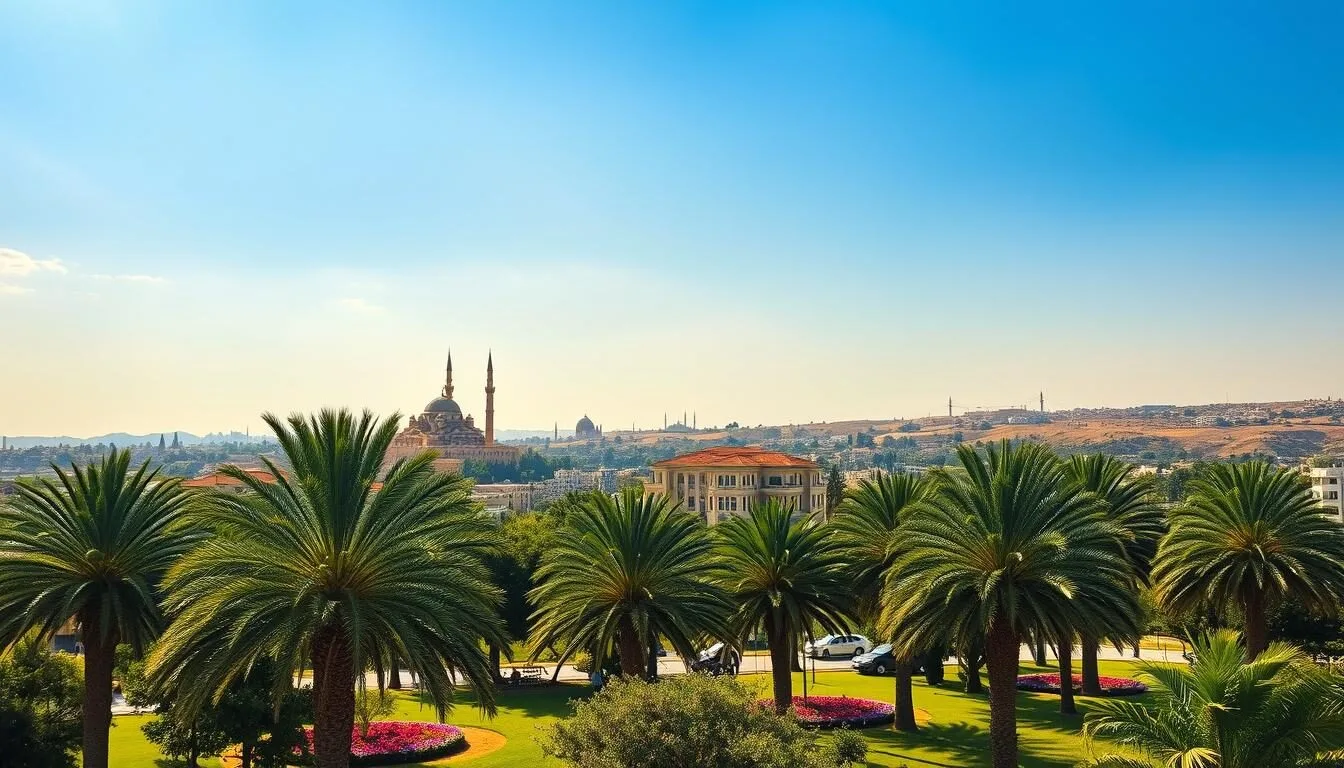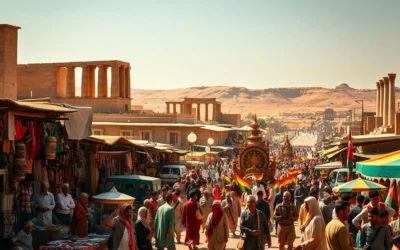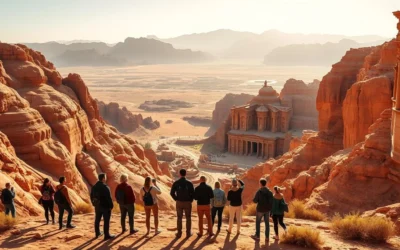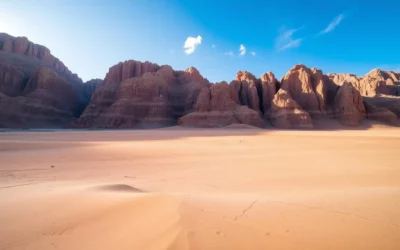✓ Accommodations ✓ Flights ✓ Rental Cars ✓ Tours & Activities
Understanding the local weather patterns is crucial to enjoying the country’s rich history and breathtaking landscapes. Visiting during the optimal season ensures that you can explore ancient ruins, such as Petra, and enjoy the stunning views of Wadi Rum without the hassle of extreme temperatures.
Timing your visit right can dramatically enhance your travel experience, allowing you to enjoy Jordan’s treasures in comfort. Whether you’re interested in hiking, sightseeing, or simply relaxing by the Dead Sea, knowing the best time to visit is key to a successful trip.
By understanding Jordan’s unique climate and seasonal changes, you can plan an itinerary that maximizes your enjoyment and minimizes weather-related challenges.
Understanding Jordan’s Climate
Jordan’s diverse climate is a key aspect to consider for a seamless travel experience. This Middle Eastern gem experiences a range of weather conditions throughout the year, making it essential to plan your trip accordingly.
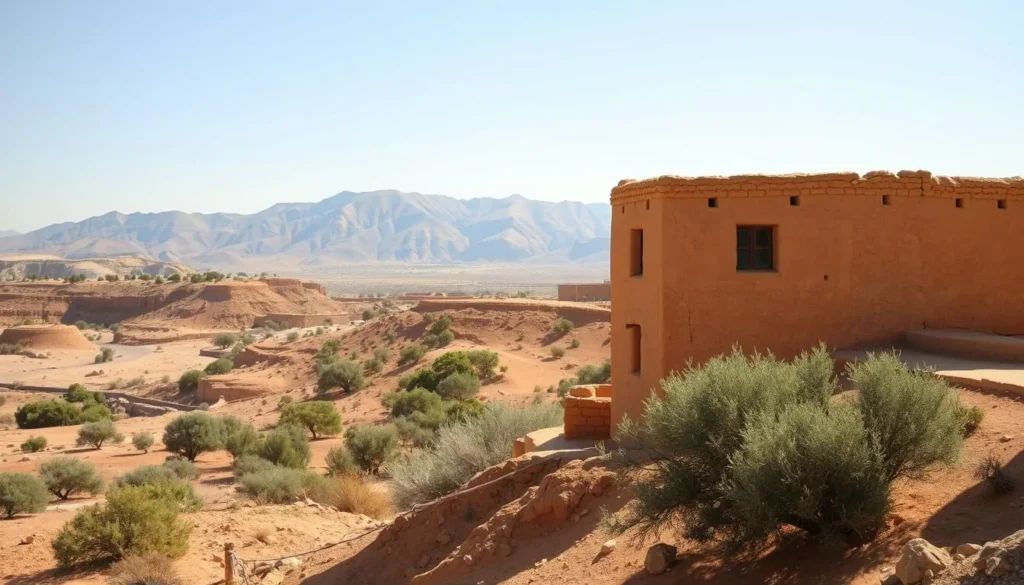
Four Distinct Seasons in the Middle East
Jordan has four distinct seasons, each offering unique opportunities for exploration. Whether you’re visiting ancient ruins or trekking through desert landscapes, the weather plays a significant role in your travel experience. Spring and fall are considered the best times to visit, with moderate temperatures making outdoor activities comfortable.
- Spring brings mild temperatures, ideal for sightseeing and outdoor activities.
- Summer can be intensely hot, especially in the desert regions.
- Autumn offers pleasant weather, perfect for exploring historical sites.
- Winter requires warm layers, particularly in the evenings.
How Weather Impacts Your Travel Experience
The weather in Jordan directly impacts your journey, affecting everything from comfort levels to the accessibility of certain attractions. Understanding the climate helps you choose the optimal time for your specific travel goals, whether you’re looking for adventure, cultural immersion, or relaxation.
By considering the seasonal weather variations, you can plan your trip to travel Jordan with confidence, ensuring a memorable and enjoyable experience. Whether you’re exploring the ancient city of Petra or relaxing at the Dead Sea, the right weather conditions can make all the difference.
Seasonal Weather Patterns in Jordan
Understanding Jordan’s seasonal weather patterns is crucial for planning a successful trip. The country’s climate varies significantly across different seasons, impacting the travel experience and the popularity of various attractions.
Spring (March-May) Overview
Spring in Jordan brings mild temperatures, ranging from 60°F to 80°F (15°C to 27°C), and blooming landscapes, making it an ideal time for outdoor activities and photography. The pleasant weather conditions during spring allow visitors to explore Jordan’s historical sites and natural beauty without the intense heat of the summer months.
Summer (June-August) Conditions
Summer in Jordan can be challenging, with temperatures soaring to between 85°F and 100°F (29°C and 38°C). It’s essential to plan explorations for early morning or late evening to avoid the midday desert heat. Despite the heat, summer is a good time to enjoy the beaches and water activities at the Red Sea.
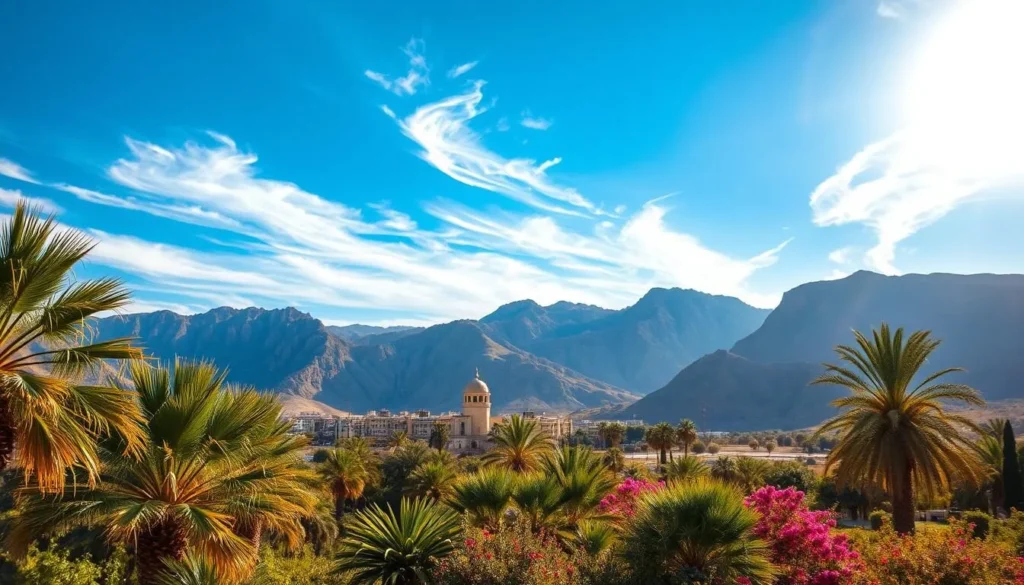
Fall (September-November) Climate
Fall offers a perfect balance with comfortable temperatures, ranging from 70°F to 85°F (21°C to 29°C), and fewer crowds, creating ideal conditions for cultural tours and extended day hikes. The fall season is particularly pleasant in regions like Petra, where the weather is conducive to exploring the ancient city’s wonders.
Winter (December-February) Weather
Winter brings cooler weather, with temperatures between 40°F and 60°F (4°C and 15°C), and occasional rain and even snow in higher elevations. This season offers a different perspective of Jordan’s landscapes but requires warmer clothing. It’s a good time for indoor activities and visiting museums and historical sites.
| Season | Temperature Range (°F) | Temperature Range (°C) | Characteristics |
|---|---|---|---|
| Spring | 60-80 | 15-27 | Mild, blooming landscapes |
| Summer | 85-100 | 29-38 | Hot, ideal for water activities |
| Fall | 70-85 | 21-29 | Comfortable, fewer crowds |
| Winter | 40-60 | 4-15 | Cooler, occasional rain and snow |
Amman, Jordan: Best Months for a Weather-Savvy Trip
Visiting Amman, Jordan, can be a fascinating experience, with its rich history and vibrant culture. To make the most of your trip, it’s essential to choose the right time to visit. The city’s climate varies significantly throughout the year, making some months more suitable for travel than others.
Spring: The Ideal Season
Spring, which spans from March to May, is considered one of the best times to visit Amman. During this period, the weather is mild and pleasant, with average highs ranging from 18°C to 25°C (64°F to 77°F). The landscapes are also particularly beautiful as flowers bloom, making it a great time for outdoor activities and sightseeing. Whether you’re exploring the Citadel, the Roman Theater, or simply enjoying the local cuisine, spring provides ideal conditions.
Fall: The Alternative Perfect Season
Fall is another excellent option. The weather during this season is similarly mild, with comfortable temperatures and fewer tourists compared to the peak summer months. The autumn season offers a great balance between enjoying the city’s attractions without the crowds and experiencing the local culture.
Avoiding Extreme Temperatures
Summer can be quite hot, with temperatures often reaching over 35°C (95°F), while winters can be chilly. To avoid the extreme temperatures, planning your visit during the spring or fall is advisable. These seasons offer the most comfortable weather for exploring the city and its surroundings.
Winter Travel in Jordan: What to Expect
Visiting Jordan during the winter months offers a unique experience. The cooler temperatures and potential for rain create a serene atmosphere, making it an ideal time to explore the country’s historical and natural landscapes without the crowds.
November to February Conditions
During the winter, Jordan experiences cooler temperatures, ranging from 12°C to 15°C (54°F to 59°F). November marks the beginning of the cooler season, and by February, the temperatures are at their lowest. While there is some rainfall, it’s typically short-lived. This makes winter an excellent time to visit popular sites like Petra and Wadi Rum without the peak season crowds.
Benefits of Off-Season Travel
Traveling to Jordan in the winter comes with several benefits, including lower accommodation costs and a more authentic experience. With fewer tourists, you can enjoy a more peaceful exploration of the country’s historical and natural sites. The cooler weather is also ideal for hiking and outdoor activities. Additionally, the possibility of snow adds a unique touch to the landscapes, making it a great time for photography.
Exploring Amman Through the Seasons
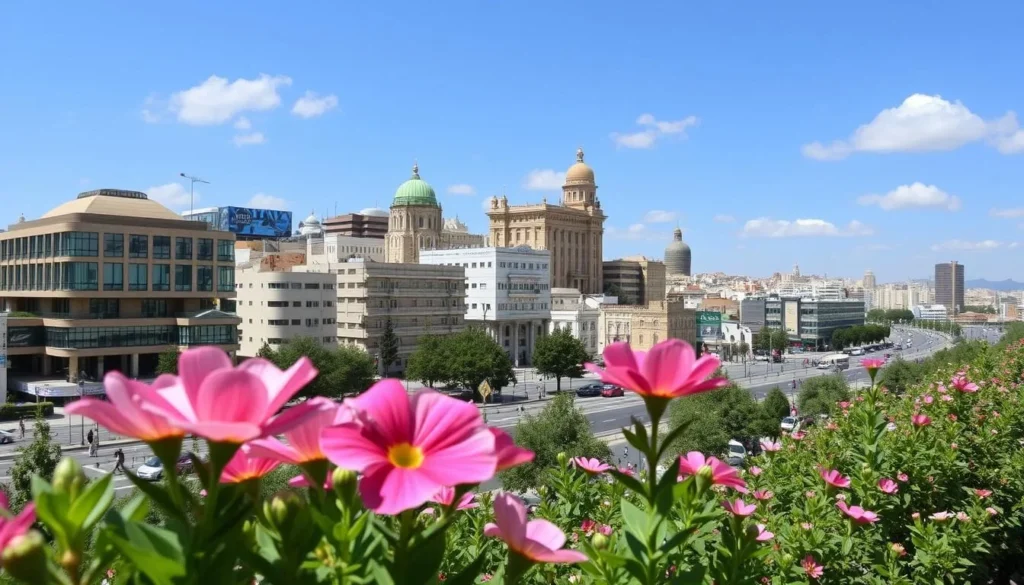
The city of Amman is a treasure trove of experiences, with each season bringing its own distinct flavor to the capital. As you explore this ancient yet modern city, you’ll discover how the weather influences the charm and character of its landmarks and cultural events.
Best Weather for City Exploration
The ideal time to explore Amman’s outdoor attractions is during the spring (March to May) and fall (September to November), when the weather is mild and pleasant. During these periods, you can comfortably visit the Citadel, Roman Theater, and the winding streets of the old city districts without the harsh summer heat or chilly winter mornings.
With comfortable temperatures, you can enjoy a leisurely day out, taking in the historical significance and architectural beauty of these iconic sites. The pleasant weather also makes it an ideal time for a stroll through the city’s parks and gardens, where you can enjoy the local flora in bloom.
Seasonal Activities in the Capital
Amman’s activities and events calendar is filled with exciting experiences that cater to all interests, varying with the seasons. In the spring, the city hosts various cultural festivals that celebrate its rich heritage, while summer evenings are perfect for outdoor gatherings in cafes and restaurants.
As travel jordan enthusiasts know, visiting during the right season enhances your experience. In Amman, you can enjoy historical exploration, culinary delights, and connecting with locals, all influenced by the prevailing weather conditions. Whether you’re wandering through bustling markets or enjoying a quiet moment in a historic place, Amman’s charm is undeniable.
Petra: Optimal Visiting Conditions
Visiting Petra, Jordan, is an unforgettable experience, but timing is everything. The ancient city’s vast archaeological site and varying weather conditions demand careful planning to make the most of your trip.
Weather Considerations
Petra’s climate is characterized by hot summers and mild winters. The best times to visit are during the spring (March to May) and autumn (September to November), when temperatures are pleasant, making it ideal for exploring the vast ruins.
Summers can be extremely hot, with temperatures often reaching over 100°F (38°C), while winters can be chilly. Understanding these conditions will help you plan your visit accordingly.
Best Times for Photography and Hiking
For photography enthusiasts, the golden hours are early morning and late afternoon. The soft, warm light enhances the rose-red color of the sandstone, creating stunning photo opportunities.
For hikers, the cooler months from October to April are ideal. These months offer comfortable temperatures for exploring the trails. Make sure to wear comfortable shoes and stay hydrated.
Wadi Rum: Desert Weather Guide
Wadi Rum, often referred to as the “Valley of the Moon,” is a breathtaking desert landscape in southern Jordan. Known for its stunning sandstone formations and vast expanses of red sand, it’s a destination that offers an otherworldly experience.
Temperature Fluctuations in the Desert
The desert climate is characterized by extreme temperature variations. Daytime temperatures can soar, while nighttime temperatures can drop significantly. This fluctuation is due to the desert’s clear skies and dry conditions, which allow for rapid heat loss at night.
Best Time to Visit
For those planning to visit, the best times are during the spring (March to May) and autumn (September to November). These seasons offer pleasant temperatures, making them ideal for camping and stargazing. Summer months can be scorching, with temperatures often exceeding 40°C (104°F), while winters can be chilly, especially at night.
Dead Sea Visits: Seasonal Considerations
Visiting the Dead Sea is a unique experience that offers a chance to relax and rejuvenate in one of the world’s most distinctive environments. The Dead Sea, known for its high salt content and therapeutic mud, is a popular destination for travelers seeking wellness and relaxation.
Best Months for Floating and Spa Treatments
The best time to visit the Dead Sea is during the spring (March to May) and autumn (September to November). During these periods, the weather is mild and pleasant, making it ideal for floating in the Dead Sea’s salty waters and enjoying spa treatments. The temperatures are comfortable, ranging from 20°C to 25°C (68°F to 77°F), which is perfect for a relaxing getaway.
These seasons offer the best conditions for experiencing the full range of activities available at the Dead Sea, from floating and spa treatments to hiking and exploring the surrounding area.
Weather Impact on the Dead Sea Experience
Weather plays a significant role in determining the quality of your visit to the Dead Sea. Extreme temperatures, either too hot or too cold, can affect your comfort and overall experience.
Summer months can be very hot, with temperatures often reaching over 38°C (100°F), making it uncomfortable to be outside during the peak sun hours. On the other hand, winters can be cool, especially in the mornings and evenings, which might limit your ability to enjoy outdoor activities.
Jordanian Festivals and Cultural Events by Season
Jordan is known for its rich cultural heritage, which is beautifully showcased through various festivals and events that take place throughout the year. These celebrations offer a unique glimpse into the country’s traditions, music, and art, making them an integral part of the Jordanian experience.
Jerash Festival
The Jerash Festival, held in July, is a highlight of Jordan’s cultural calendar. This festival transforms the ancient Roman ruins of Jerash into a stage for music, dance, and theater performances. It’s an opportunity to experience the best of Jordanian and regional talent.
Aqaba Traditional Arts Festival
In February, the Aqaba Traditional Arts Festival celebrates the region’s cultural richness. This event showcases local artisans’ skills in crafts, textiles, and more, providing a glimpse into the traditional ways of life in Jordan.
Other Seasonal Celebrations
| Month | Festival/Event | Description |
|---|---|---|
| July | Jerash Festival | Music, dance, theater |
| February | Aqaba Arts Festival | Traditional arts and crafts |
Experience the vibrant culture of Jordan by attending one of these festivals during your visit.
Outdoor Adventures: Weather-Based Planning
Jordan offers a diverse range of outdoor adventures that can be enjoyed throughout the year, provided you plan according to the weather. Whether you’re hiking, camel riding, or stargazing, understanding the seasonal weather patterns is key to a comfortable and safe experience.
Hiking in Dana Biosphere Reserve
The Dana Biosphere Reserve is a must-visit for nature enthusiasts. The trails offer stunning views and a chance to connect with the land’s rich culture. The ideal time for hiking here is during the spring (March to May) and autumn (September to November) when temperatures are mild, making day-long treks enjoyable without the excessive heat or cold.
Camel Safaris in Optimal Conditions
For a unique desert experience, consider a camel safari in Wadi Rum. These excursions are best enjoyed during the cooler parts of the day, especially in March, May, or September. Avoid the midday heat and chilly desert nights for a more comfortable ride.
Stargazing in Wadi Rum: Best Months
Wadi Rum‘s clear skies make it a paradise for stargazers. The desert’s remote location offers minimal light pollution, creating perfect conditions for observing the night sky. Visit in February or April for the best visibility. The clear skies and comfortable night temperatures make these months ideal for stargazing.
- Plan your outdoor adventures according to Jordan’s seasonal weather for the best experience.
- Enjoy hiking in Dana Biosphere Reserve during spring and autumn.
- Time your camel safaris in Wadi Rum to avoid midday heat and chilly nights.
- Visit Wadi Rum in February or April for optimal stargazing conditions.
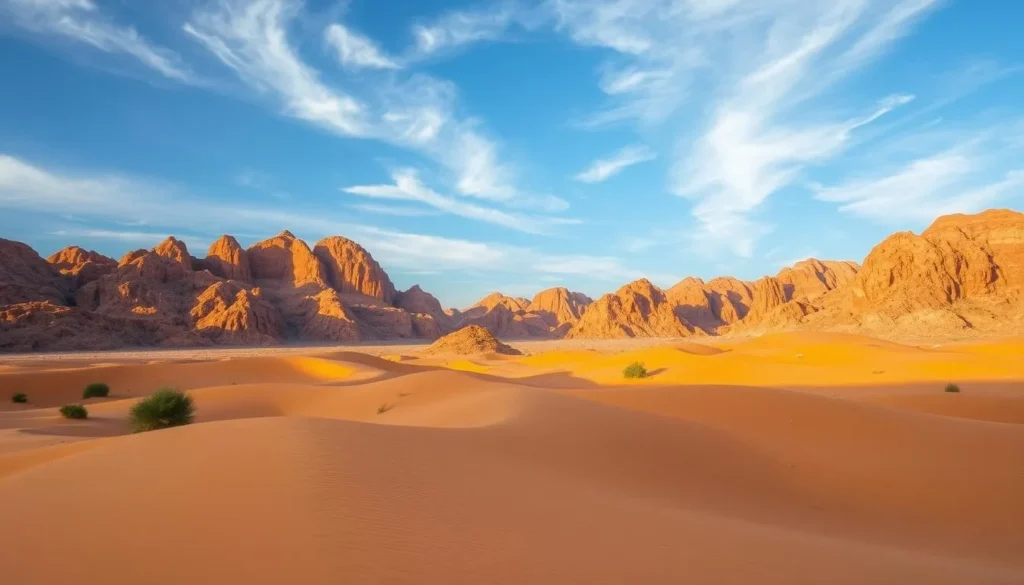
Packing Tips for Jordan’s Variable Climate
Jordan’s diverse climate demands careful packing to ensure you’re ready for any weather scenario. Whether you’re exploring bustling cities or venturing into the desert, the right gear makes all the difference.

Essential Items for Any Season
Regardless of when you visit Jordan, there are certain essentials you should always pack. Comfortable walking shoes are a must for city explorations, especially in places like Amman. Sun protection, including sunscreen, a hat, and sunglasses, is crucial for outdoor activities. Modest clothing for cultural sites and versatile layers for temperature fluctuations are also essential.
For desert tours, lightweight, breathable clothing is a necessity. However, don’t forget to pack a warm layer like a fleece or jacket for chilly evenings.
Season-Specific Packing Lists
Each season in Jordan brings its unique weather challenges. For summer, prioritize heat-resistant clothing and hydration packs. In winter, pack warm clothing for chilly mornings and evenings. Spring and fall require versatile layers to adjust to temperature variations.
- Summer: Lightweight clothing, sun protection, hydration packs
- Winter: Warm clothing, layers for temperature control
- Spring and Fall: Versatile layers, comfortable walking shoes
By packing smartly and considering the season, you’ll be well-prepared for your Jordanian adventure, whether you’re exploring the desert or enjoying the city’s attractions.
Month-by-Month Weather Guide for Jordan
The key to a successful trip to Jordan lies in understanding its monthly weather patterns. Jordan’s climate varies significantly across different regions and seasons, making it essential to plan your visit according to the weather conditions.
Temperature and Rainfall Insights
Jordan’s temperature and rainfall patterns change dramatically throughout the year. In December, temperatures in Amman average around 50°F (10°C), while Petra experiences slightly cooler weather. Rainfall is more common during this time, especially in the northern regions, making it a quieter period to explore. In contrast, summer months bring scorching temperatures to desert areas like Wadi Rum, often exceeding 100°F (38°C), although nights can be refreshingly cooler. Understanding these patterns can help you pack accordingly and make the most of your trip.
For instance, if you’re planning to visit the Dead Sea during the summer, be prepared for hot weather, while a winter visit might be more pleasant in terms of temperature. The rainfall probabilities for key destinations like Amman, Petra, Wadi Rum, and the Dead Sea vary significantly across the months, and being aware of these can help you plan your itinerary.
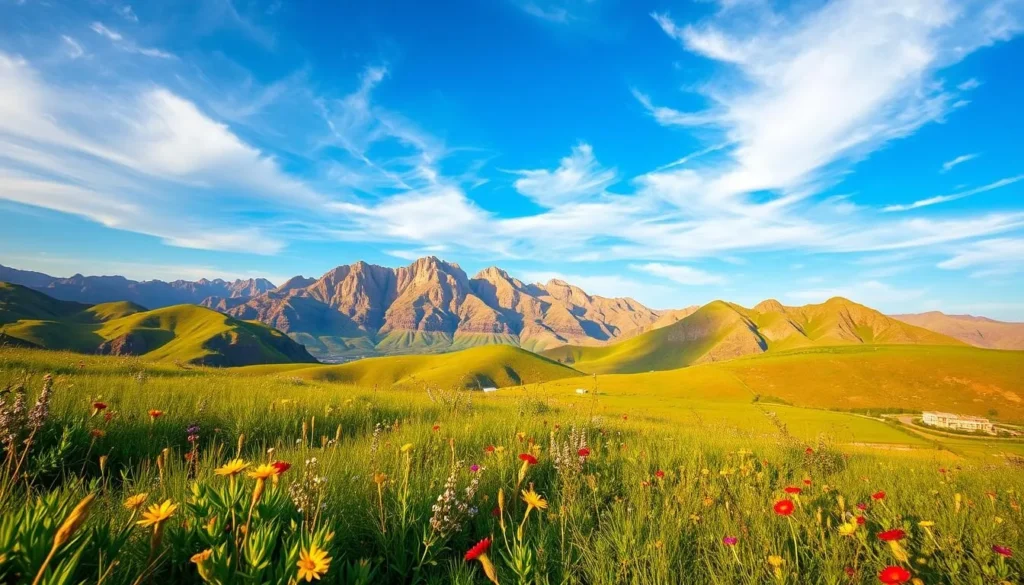
Comparing High and Low Seasons
Understanding the high and low tourist seasons in Jordan can help travelers make informed decisions about their trip, especially those on a tight budget. During the low season, prices for tours and accommodations tend to drop, making it an attractive time for budget-conscious visitors. However, it’s crucial to balance the cost savings with the weather conditions to ensure a pleasant experience.
For example, visiting during the shoulder season can offer a great balance between comfortable weather and affordable prices. Whether you’re flexible with your travel dates or have specific times of the year in mind, this guide helps you set realistic expectations and make the most of your visit to Jordan’s diverse attractions.
Planning Your Weather-Savvy Jordan Itinerary
When planning your trip to Jordan, creating a weather-savvy itinerary is crucial for maximizing your experience. By considering the country’s seasonal weather trends, you can ensure a seamless and enjoyable journey.
Aligning Your Visit with Optimal Weather
To make the most of your trip, it’s essential to align your visit with the optimal weather conditions for key attractions like Petra, Wadi Rum, and the Dead Sea. Mild temperatures in spring and fall are ideal for outdoor activities and sightseeing. During these seasons, you can explore ancient ruins, take part in outdoor adventures, or simply relax by the Dead Sea without the harsh weather conditions.

For instance, visiting Petra during the spring allows you to enjoy the ancient city’s beauty without the scorching summer heat. Similarly, a fall visit to Wadi Rum offers pleasant temperatures perfect for camping and stargazing. By choosing the right time to visit these locations, you can enhance your overall experience.
Balancing Weather, Budget, and Attractions
Balancing weather considerations with budget constraints is vital for a successful trip. Booking accommodations and tours in advance, especially during peak travel periods, can help you secure better rates and avoid last-minute stress. Consider traveling during the shoulder seasons when the weather is still favorable but the prices are more affordable.
For travelers on a budget, planning your trip during the off-season can offer significant savings. However, it’s crucial to weigh the benefits against the potential drawbacks, such as some attractions being less accessible or certain tours not operating. By being flexible with your travel dates and planning ahead, you can create a weather-savvy itinerary that meets your needs and budget.
Conclusion
Armed with knowledge of Jordan’s seasonal weather patterns, you’re now ready to plan a trip that meets your expectations. You’ve gained comprehensive insights into the best months for a weather-savvy trip to Amman and Jordan, understanding how seasonal variations affect your experience at iconic sites like Petra, Wadi Rum, and the Dead Sea.
The guide has equipped you with practical knowledge about Jordan’s climate patterns throughout the year, helping you plan your visit during optimal weather conditions whether you’re exploring ancient ruins, floating in mineral-rich water, or camping under desert stars. This information enables you to balance weather considerations with budget constraints, maximizing your travel experience while finding the best value on tours, accommodations, and activities across the country.
Whether you’re drawn to Jordan for its world-famous archaeological sites, breathtaking desert landscapes, or unique natural wonders, you now understand the best times to visit each place based on your personal preferences and tolerance for heat, cold, or rain. Generally, spring (March-May) and fall (September-November) offer the most pleasant conditions for exploring the country’s diverse attractions.
With this weather-savvy approach to planning your Jordan journey, you’re set to experience the country’s treasures in the most comfortable and rewarding way possible, creating memories that will last a lifetime. You’re now ready to plan an unforgettable Jordan trip that aligns perfectly with optimal conditions for your chosen activities, whether that’s hiking through Petra, stargazing in Wadi Rum camps, or experiencing the country’s rich cultural heritage through seasonal festivals and local experiences.
Jordan offers remarkable experiences throughout the year, with each season providing its own reason to visit, from winter’s quiet contemplation to summer’s vibrant festivals. By adapting your travel plans based on the season, you can take advantage of unique seasonal opportunities and make the most of your trip.
—
The above is subject to change.
Check back often to TRAVEL.COM for the latest travel tips and deals.
